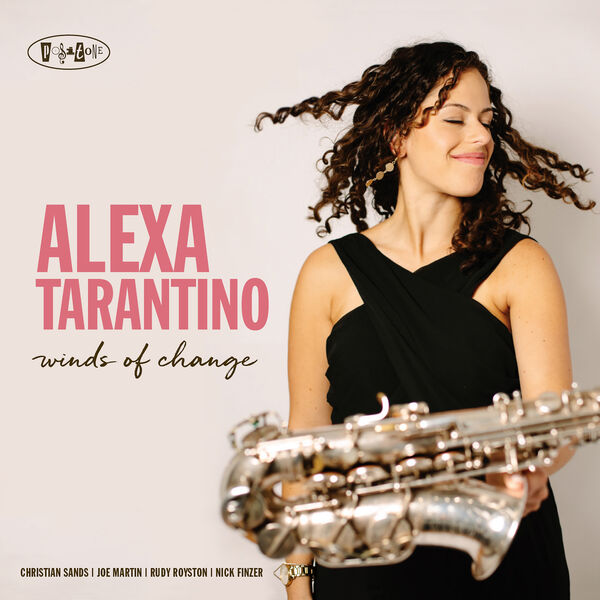Get to Know This Dynamic Saxophonist: Alexa Tarantino
Date Posted: May 28, 2019

Photo by Anna Yatskevich
How did you get your start on saxophone and when did you know you wanted to pursue jazz?
I started playing saxophone in the fourth grade at my elementary school in West Hartford, CT. I started piano at the same time as well. My parents are not musicians, but they coincidentally raised us in West Hartford which had outstanding music departments (specifically jazz) in the public schools. My parents took me see to one of the concerts at Hall High School when I was in third grade. I saw a young woman playing a ballad on the saxophone and I immediately tugged on my mom’s sleeve and said that was what I wanted do. It’s a little unusual, but I knew right from the beginning that I wanted to play jazz saxophone!
You recently finished your graduate degree in Jazz Saxophone Performance at The Juilliard School. What was it about that program that interested you?
Yes, I had a great experience at Juilliard! I took a couple of years off in between my undergraduate studies at the Eastman School of Music and moved to New York City to freelance. After that, I applied to Juilliard. At Eastman I had received degrees in Jazz Saxophone Performance and Music Education, with a Certificate in Arts Leadership. I had completed a lot of education in a short amount of time, but felt that there were still some areas that I wanted to dig deeper into with the guidance of a curriculum or school setting. I wanted to be challenged, expand my network, gain new perspectives from peers and professors, sharpen my knowledge of jazz history, and to hone my compositional skills. Most importantly I just wanted to play as much as possible with as many different people as possible. I made some great friends and was able to study with and learn from both my teachers and my peers.
What is your practice routine like and how has it evolved?
I’m always thinking about how I can develop and refine my practice routine. I used to have a very strict regimen with categories and time frames which worked really well for me at Eastman. I could get anywhere from four to eight hours a day in and really maximize small windows of time that I had between classes. I followed a similar regimen in the years before entering Juilliard. In graduate school, my approach was less strict and more about working on what was most time-sensitive and getting as much time in as I can without burning out. I was playing and performing a lot more than I was practicing. But now that my mornings have opened up, I am excited to get back to my routine!
I have a list of categories that I want to hit every day: long tones, overtones, some scales/patterns, vocabulary in all 12 keys, blues or rhythm changes in all 12 keys, learning a new tune or working on developing ideas over a tune, and more. Many days I’m not able to get to all of these, so I try to keep note of what I can get to, and then change it up the next day. Some days I’ll maybe get 5 minutes each on long tones and overtones, 10 minutes on taking a pattern through all the keys, and 20 minutes playing the blues in all keys working on a particular tempo or style, and then I’m out for the day. Other days I am able to plan for longer. I try to keep things fresh and have a handful of approaches or exercises that I can do in each category, so that I’m still hitting the basic goals each day, but with a slightly different focus or approach. If time allows, I will set my alarm so that I practice for 50 minutes, take a 10 minute break, repeat, and so on. I also generally start my day with flute and will add my other woodwind doubles into the mix if time allows.
"I try to keep things fresh and have a handful of approaches or exercises that I can do in each category, so that I’m still hitting the basic goals each day, but with a slightly different focus or approach." - Alexa Tarantino
Tell us about the Rockport Jazz Workshop that you founded and are the director. What is it and when does it take place?
Rockport, Massachusetts has been a special place for me because it is where my mom’s family is based. I spent a lot of my childhood visiting family and spending summers there.
Rockport Music is a non-profit organization in the area that I noticed was programming mostly classical artist and education/outreach opportunities. Because I had an opportunity to intern on behalf of Eastman’s Arts Leadership Program, I knocked on the door at Rockport Music and asked if they would have any interest in me starting a jazz camp there.
We are six years in and have grown from 7 students working with me in that first summer, to a two-week program with 120 students, 10 faculty, 2 interns, and 2 guest artists. It’s been amazing to watch the students learn and grow from year to year.
The program occurs in the last two weeks of July. We teach mostly by ear and accept students ages 10-18 with 1-2 years of previous experience on their instruments.
We are currently a day program but are hoping to expand to overnight. I’ve been so lucky to bring amazing guest artists such as Jimmy Greene, Sherrie Maricle, Ulysses Owens, Jr. and Lauren Sevian to the Rockport Jazz Workshop. In addition, I’m able to hire some of my best friends who are not only great players but incredible educators. Many of them received their education credentials at Eastman as well and trained in the same method that we promote. I am so proud of our faculty who can customize their instruction to students needs and work with students at any age or ability level while also inspiring improvisation and creativity.
What’s the solfège singing all about and when did you start doing that? What has it done for you in developing your skills as a musician?
Haha! I’m starting to get this question a lot. It’s this silly thing that I realized I could do. I’ve been exposed to solfège since I first started studying music in the Kodaly method.
Since then, my brain has always associated pitches with syllables. At Eastman I studied both fixed and movable Do. Juilliard’s Ear Training program was fixed Do as well. I could do all of those, but in terms of how I hear music outside of the classroom and when I’m playing, I realized I heard everything as it related to Concert B-Flat being “Do”. People would ask me to solfège bebop heads on the spot which is when I started posting videos on social media using #solfegesaturday.
Some people don’t believe that I can do it off the top of my head, so I may just do an Instagram Live session one day :) Solfège has helped me to develop strong relative pitch, it has strengthened my intonation, my technique, sight-reading, and my understanding of harmony and voice leading. I recommend it to everyone!
You have a new CD releasing at the end of May. What is the story behind this new release?
Yes! Winds of Change will be out on Posi-Tone Records on May 31st. It’s currently available for exclusive pre-order on my website (www.alexatarantino.com/shop). We’ll be celebrating the release at Dizzy’s Club on Tuesday May 28th at 7:30PM only! I’m so thrilled to have an amazing band on the record: Christian Sands on piano, Joe Martin on bass, Rudy Royston on drums, and Nick Finzer on trombone. Ulysses Owens, Jr. will be playing drums at the CD Release Celebration.
The record contains almost all original compositions. Some are older and some were composed for the record. It’s a documentation of my musical self up to this point. It is my first quartet record, and is my first record as a leader for Posi-Tone. I’m playing alto saxophone, soprano saxophone, and alto flute on it as well. Hope you enjoy it!
What are your Vandoren setups?
Alto Sax:
Yamaha YAS-82ZIIS (Silver-Plated with the Sterling Silver E1 Neck)
Vandoren V5 Jazz (A35 Tip Opening) Mouthpiece
Vandoren M|O Ligature (Gold-Plated)
Vandoren ZZ Reeds Size 3
Soprano Sax:
Yamaha YSS-675 Soprano
Vandoren V5 Jazz (S35 Tip Opening) Mouthpiece
Vandoren M|O Ligature (Gold-Plated)
Vandoren ZZ Reeds Size 3
Bb Clarinet:
Buffet R13 Clarinet
Vandoren M30 Profile 88 Mouthpiece & Vandoren B45 Mouthpiece
Vandoren M|O Ligature (Gold-Plated)
Vandoren V21 Reeds Size 3.5
